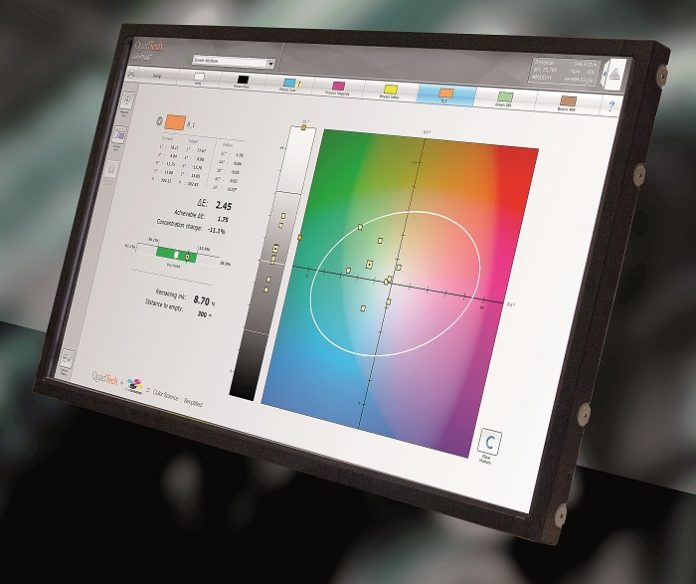
Leading Indian newspaper, commercial and packaging printers use automated and sometimes closed registration and color quality control systems on their high speed and increasingly on their medium speed web presses. For instance, HT Media uses QuadTech controls on both its manroland Colorman presses 4 x 2 presses and its TKS 4 x1 presses. The Printers Mysore, publishers of Deccan Herald have put QuadTech controls on their newer Manugraph 45,000 copies an hour 2 X 1 presses also. Many other automation systems have been put in place at Indian newspapers focused on maximum yield of newsprint and other consumables. They have become very focussed on both wastage and costs as well the environment audits of their plants which are amongst the most efficient and greenest in the world—Editor
When printers talk about protecting the environment, they usually speak of recycling paper; using paper from sustainable sources; reducing the use of solvents; moving from chemical film and plate processing to CtP, and other high-profile, printrelated causes of pollution and waste. What is less well appreciated is the positive effect of modern press controls on the environment. When considering the end-to-end impact of your company’s activities, this is worth attention, even if you have the other issues under control.
Indirect impact, direct results
Installing the right measuring and quality control solutions on your commercial, newspaper or packaging web presses can impact the performance of your business – and the environment – in a number of ways:
- Using register controls, color management and color control systems, or 100% web inspection systems, for example, can minimize material waste by ensuring that color-accurate and defect free copy is sent to customers.
- Not only is waste eliminated, but also the cost of delivering print that would be rejected and shipped back, and the cost of disposing of the waste. While paper products can be recycled or burned, films and sophisticated laminates may require more controlled – and more expensive – disposal methods. By freeing your presses from profitless reprints of rejected jobs, more press-time is gained and throughput is increased.
- The energy savings of not running waste material combined with the energy used in plate preparation – especially with flexographic plates – is considerable. Unnecessary flexo plate production not only wastes energy, but, depending on the system, also large quantities of water which will require filtration before disposal.
Delivering the results, incrementally
While press controls are primarily designed to ensure quality, improve press speeds and increase margins, incremental savings of materials, ink, energy and water will have a positive cumulative effect on the environment. A number of quality control and automation systems can contribute to these results:
Commercial printers and converters can achieve faster make-readies and accurate color assurance at full press speeds with systems such as the QuadTech Color Control System with Instrument Flight & SpectralCam. SpectralCam’s spectrophotometer measures L*a*b and Delta-E to ensure that what is printed meets customer specifications. Color information about the run can reported and stored in the system’s centralized data storage and called up for future repeat runs with equal efficiency and reduced waste.
For packaging converters, there are a number of PDF verification systems that can scan every sheet at full press speed and compare these to a customer-approved ‘golden template.’ These systems identify missized or missing images and incorrect fonts before the job is run with the ability to dramatically improve job accuracy and the potential for spoiled print. Many systems can also spot deterioration or filling up of small type which can be critical for text required for regulatory compliances.
Total or 100% inspection systems provide optimal quality control and waste reduction by inspecting 100% of the web 100% of the time. The system notifies operators of process and random faults, with defect information sent to the waste management system for remedial decisions to be acted upon. The system can even take control of the rewinder and run it at optimum speeds for removal of defective copy.
Also offering improved productivity and reduced waste, systems with spectrophotometric measuring cameras enable accurate inline color measurement for the widest variety of substrates, eliminating the need for operators to stop the press and remove a section of the web to measure color. It is claimed that using these systems in combination with automated correction and control options, customers are able to reduce press stops by 50% on average at make-ready.
Time, cost and waste saving solutions for web presses
Apart from building a reputation for supplying defect free, highquality print, printers and converters can demonstrate environmental responsibility by using materials efficiently, saving energy and dramatically reducing the amount of waste materials shipped. For printers and converters looking to supply big blue chip brands, being able to support their environmental and sustainable policies and aspirations has quickly become a prerequisite, with press controls being a natural choice in ensuring consistent high standards. Increasingly, brand owners would like to have a quality report of the materials supplied to them.
Modern quality monitoring and closed loop correction systems offer a quantifiable means to reducing a business’s environmental footprint and, in doing so, contribute to the overall profitability of print and converting businesses by increasing production efficiency and using resources efficiently and responsibly.
















